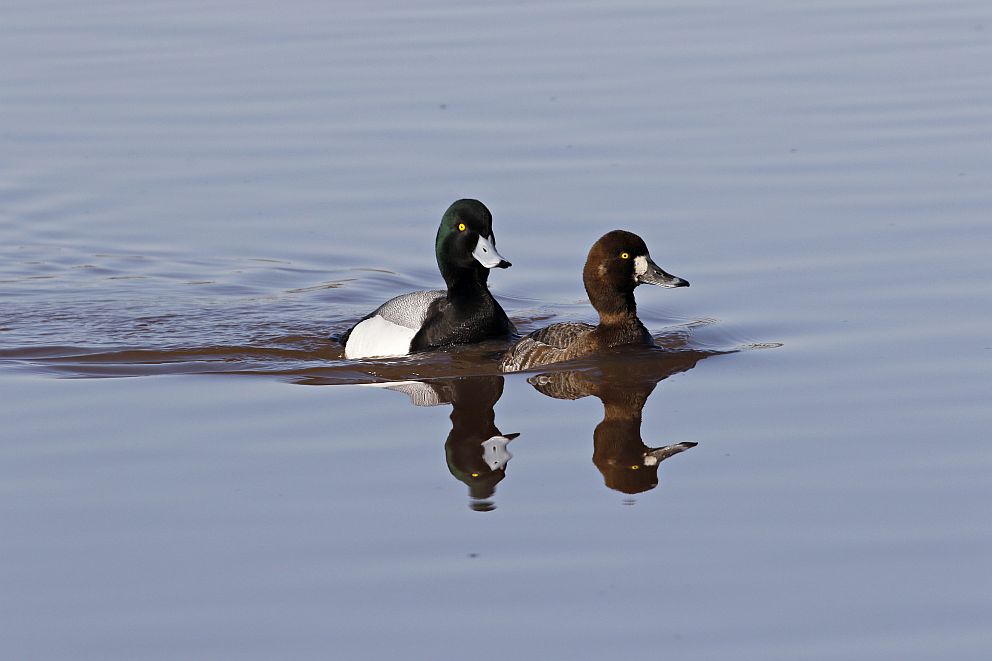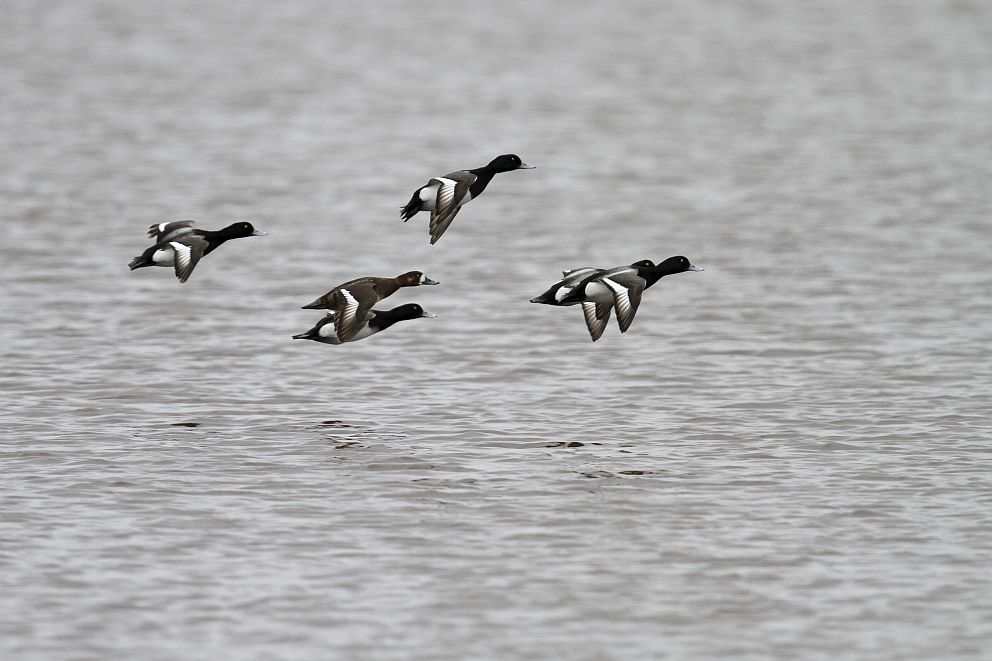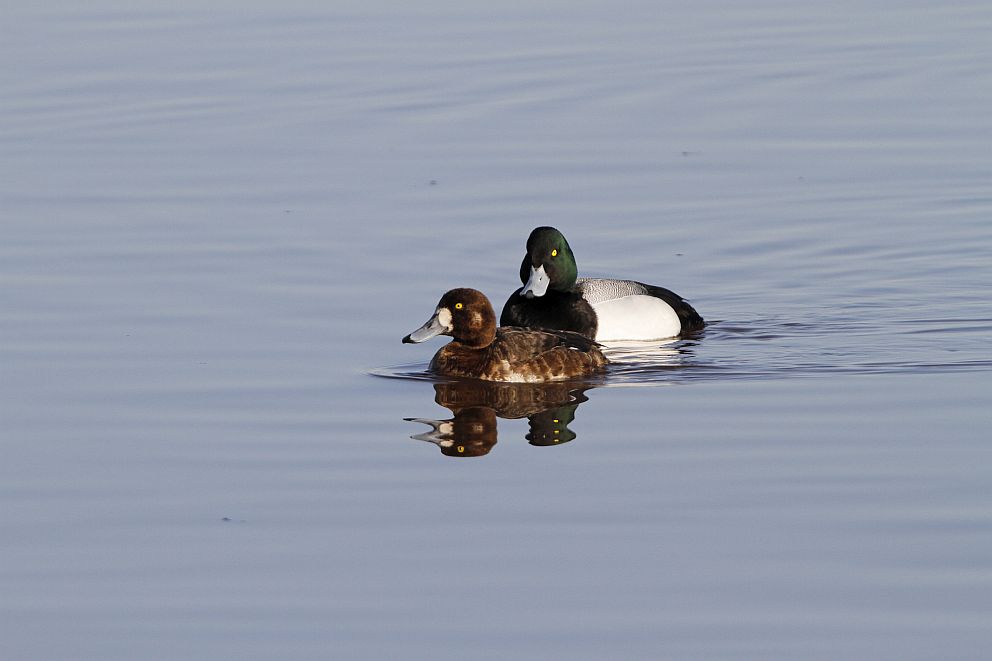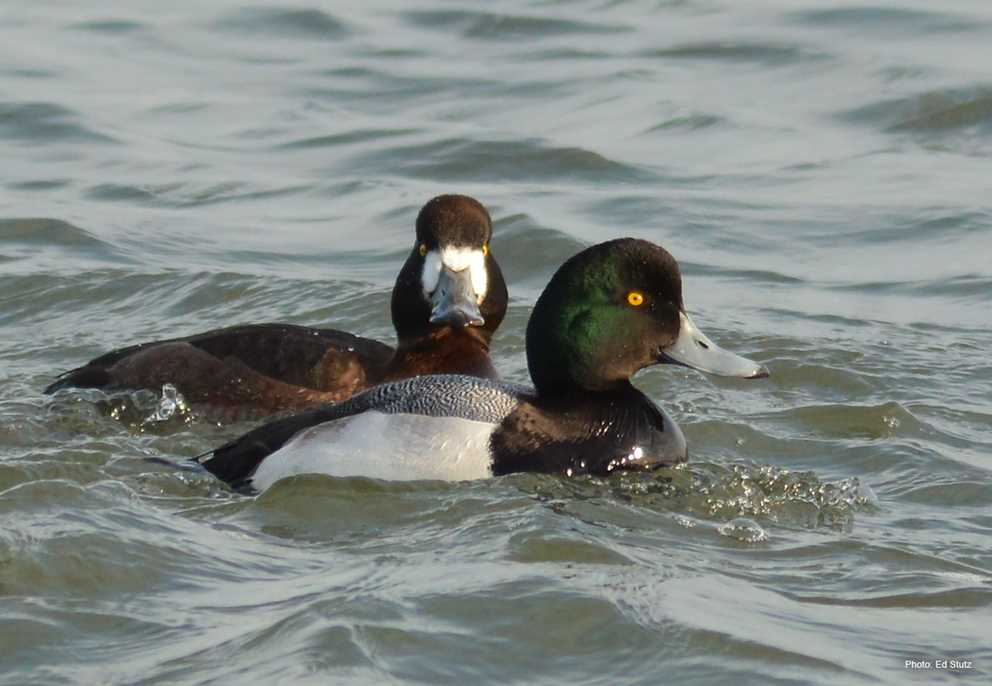Overview
The Greater Scaup is a medium-sized diving duck with a circumpolar breeding distribution across North America, Europe, and Asia. They are difficult to distinguish from the Lesser Scaup. Their head may appear more rounded in both sexes compared to the Lesser Scaup. Males have a black head and may show iridescent tones of dark green. They have a pale blue bill (scaup are often called “blue bills”) that is wider than the Lesser Scaup’s, with a notable black nail that is larger than that of the Lesser Scaup. The belly is white.
Females are brownish, with a conspicuous white area at the base of the bill. Their breeding habitat is freshwater wetlands in Arctic western Canada, and especially Alaska. Migration and winter habitat includes the Great Lakes and coastal bays and marshes.
Description
Key Identification Features
- The Greater Scaup has a pale blue bill with a large black nail.
- Males have a striking black head which may show iridescent colors in light.
- Females have a white patch at the base of the bill, but unlike Ring-necked Ducks, have no white ring on the bill itself.
- In flight, both sexes show bold white stripes on the secondary feathers that extend into the primary feathers.
Male/Female Average Length and Weight
- Weight: Males 2.3 lbs.; Females 2.1 –2.2 lbs.
- Wingspan: Males 8.6 in.; Females 8.3 in.
Male Identification
- Alternate (Breeding) Plumage: Males have a round, large black head, neck, and breast, with iridescent tones of blue, purple, or green, depending on the light. Their pale blue bill features a large black nail, and their iris is yellow to golden. The back and sides are white with black vermiculation, and the belly is white.
- Basic Plumage: A dull brownish-gray plumage with a dull gray-blue bill, typically attained in summer (July/August) during molt.
Female Identification
- Females are shades of brown with a white patch at the base of their blue-gray bill that has the same black nail as males. Both alternate (breeding) and basic plumages are similar, though the white patch may be less noticeable in the basic plumage. Females also have white belly feathers.
In-flight Identification
- Males Greater Scaup have a round black head, neck, and breast; head may show iridescent tones of dark blue, purple, or green depending on angle of light. They display a bold white stripe on their secondary feathers that extends into the primary feathers (Lesser Scaup do not have white extending onto the primary feathers).
- Females have darker brown heads with a lighter brown neck and white belly feathers. Like males, females also show the white stripe on secondary and primary feathers during flight.
Vocalizations
- Males: Usually quiet but may give a “whee-oooo” call during courtship.
- Females: emit a purring “kaaaar, kaaar, kaaar" in flight. Female alarm call is a harsh “scauuup.”
Similar Species
- Lesser Scaup: Greater Scaup are similar in appearance to Lesser Scaup, but Greater Scaup has a rounder, larger head, wider bill, and inflight, the white stripe extends into the primary flight feathers. These two species can be difficult to separate, sometimes even when in the hand.
- Ring-necked Ducks: Ringneck males have more uniform black back and uniquely patterned white on flanks. Male and female ringnecks have a prominent black tip and white ring on the bill in contrast to the uniform bluish bill in Greater Scaup.
Habitat Preferences
- Breeding: Permanent to semi-permanent Arctic tundra wetlands.
- Migration and Wintering: Large bodies of water including the Great Lakes, coastal bays, nearshore marine environments. They are less commonly found on inland freshwater systems other than the Great Lakes.
Foraging Habits and Diet
- Breeding Season: On breeding areas, they are not well studied, but feed heavily on invertebrates.
- Migration and Winter: The diet shifts to include small mussels and clams, including invasive zebra mussels in the Great Lakes.
Breeding Habits
- Monogamy: Seasonally monogamous, forming new pair bonds each year, usually in late spring.
- Nest Locations: Typically nest in pond margins in associated sedges and grasses. Nests are typically small depressions with some stems of vegetation lining the nest bowl.
- Clutch Size: Average of 8–9. Eggs are dark olive-buff and elliptical in shape. Incubation lasts around 24–25 days.
Migration and Distribution
- Fall Migration: Greater Scaup are among the latest waterfowl to leave their northern breeding grounds, departing in moderate to large flocks in late October or November, with peak numbers arriving in wintering areas in mid-December to February. Migration is often nocturnal and associated with post-cold front northerly tail winds.
- Spring Migration: Spring migration is drawn out, may begin as early as February, but birds do not arrive on Arctic nesting areas until May.
- Changing Patterns: Warmer winters and abundant zebra mussels have led some Greater Scaup to winter in the Great Lakes.

Conservation Status
- IUCN Status: Least Concern
- Population Status: Greater and Lesser Scaup are combined in the USFWS Breeding Waterfowl Survey since they cannot be distinguished during aerial counts. The survey shows a long-term decline from 7 million in the early to mid-1980s to 4 million in 2024, 16 percent below the survey's long-term average. The decline is mostly related to Lesser Scaup, particularly those nesting in the Western Boreal Forest.
- Conservation Concerns: Habitat degradation in the Western Boreal Forest and loss of food resources during migration and wintering periods are key concerns. Exposure to contaminants and low female survival rates are additional threats.
- Conservation Focus: Conservation efforts emphasize sustainable management of Arctic tundra and improving wetlands used as spring staging areas, with a focus on enhancing water quality to promote healthy invertebrate populations that are an essential food source for scaup.
Harvest Information
- An average of 40,863 greater scaup were harvested across the US during the 2019 through 2022 hunting seasons.
- Greater scaup harvest is typically highest in the Mississippi Flyway, accounting for 40 to 50 percent of the total US harvest.
- The top three states for Greater Scaup harvest, based on annual averages across the 2019–2022 hunting seasons, were Wisconsin (5,489), Oregon (4,858), and Maryland (4,301).




